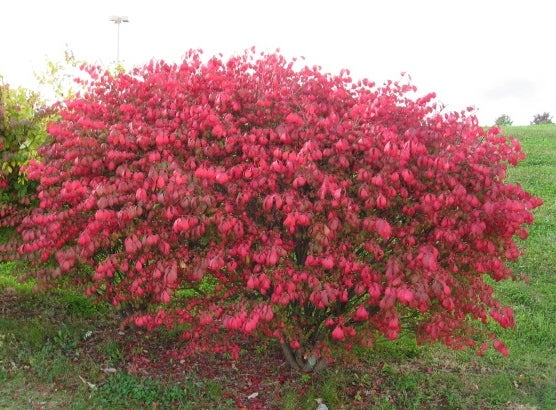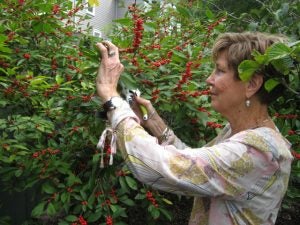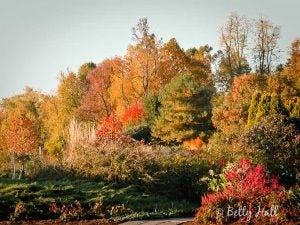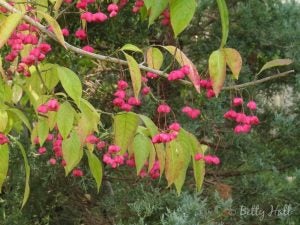The burning bush is gorgeous, but you may not know the danger
Published 3:55 pm Tuesday, October 31, 2017

- Burning bush in full autumn color is a sight to see, but beware. These invasive imports from Asia are now classified as a “severe threat.” Photo by Susan Jonas.
By Susan Jonas
Garden Club of Danville
It’s hard not to love a plant as flamboyantly colorful as a burning bush in October, but you may look at Euonymous alatus with less admiration when you consider its dark side. Its many admirers won’t like to hear this, but burning bush is now officially classified as an invasive plant. In fact, Euonymous alatus is number 10 on the list of worst plant threats compiled by the Kentucky Department of Natural Resources, Division of Forestry. The Kentucky Exotic Pest Plant Council lists burning bush as a “severe threat.”
Like the ubiquitous bush honeysuckle and many other invasive plants, burning bush is an import from Asia. Here in North America, in an environment that lacks the natural controls of its country of origin, the plant has an advantage over native species and can easily outcompete them for habitat. It was brought to America, widely promoted and planted because it’s easy to grow, has few pests or diseases, and oh, those spectacular red leaves in fall.
Although there are smaller cultivars, euonymous alatus can grow to 15 feet tall and even be pruned as a small, multi-trunked tree. I visited a Lexington garden with a small grove of them that you can walk under. It was magical to look up at the blue sky through the flaming red leaves. (As I said, it can be hard not to admire them.) The natural vase shape of burning bush is more often sheared into globes or hedges.
You may think the plant is harmless because it doesn’t spread in your own garden, but it is now widely naturalized and invading Kentucky’s woodlands and untended fields. Burning bush spreads by seeds deposited over a wide area by birds that eat the small red berries in autumn. It also spreads through the root system by sending up suckers, which eventually form thickets. These dense thickets out-compete native plants and form a monoculture, like bush honeysuckle. Some eastern states have banned the importation of burning bush plants.
They are still widely sold in nurseries, big box stores, and on the internet, but that doesn’t mean we have to buy them. It’s not easy to top the fall brilliance of a burning bush, but there are native shrubs that even outshine it. The Garden Club’s Linda Porter has compiled a list of “Alternatives to Exotic Invasives” which you can find by clicking the “Resources” tab on the club’s website, thegardenclubofdanville.org.
Instead of burning bush, Linda suggests Dwarf Fothergilla, Fothergilla gardenii, ‘Jane Platt.’ This 3-foot tall shrub has white flower clusters in spring and brilliant fall color. It grows in sun or shade and is very adaptable. Linda also recommends Red Chokeberry ‘Brilliantissima’ Aronia arbutifolia, which grows to 5 feet, with bright crimson fall color and berries. This is another very adaptable shrub that thrives in either sun or light shade, wet to dry soil. For the tall shrub or small tree effect, try burning bush’s American cousin, Wahoo, Euonymous atropurpureus. The fall color of this native is bright to delicate pink, with neon pink berries that will stop traffic.

Martha Caywood uses the abundant, berry-covered branches of her winterberry shrubs, Ilex verticillati, for autumn decorating. The bright red berries and green leaves of this native holly form an informal hedge along one side of her garden. Photo by Susan Jonas.
If it’s colorful fruit you like, this time of year nothing tops the winterberry, Ilex verticillati. Garden Club member Martha Caywood has a border of these in her garden that is thick with bright red berries. Winterberry is a native deciduous holly. The leaves will fall, but the berries remain on the bare stems until eaten by birds, making them standouts for autumn decorating. Hollies require a non-fruiting male to ensure pollination. All my hollies are female with berries, so somebody else in the neighborhood must have a male holly. Like tomcats, they get around.
You may have to drive to Lexington or Frankfort to find these shrubs. Springhouse Gardens has a good selection. Why plant something as common as a burning bush when you can choose an equally colorful native shrub that won’t be duplicated all over town? As a bonus, many of them are host plants for butterflies and their berries feed the birds. This is a good time to make note of colorful plants you admire, and resolve to plant them in your own garden.

This month at the Arboretum in Lexington you can see Kentucky at its most colorful. What you won’t see is the blazing red of burning bush, Euonymous alatus. This long-time landscape favorite is now officially classified as an invasive plant. The Garden Club of Danville has suggestions for several native shrubs as more responsible choices. Betty Hall Photography.

Wahoo, Euonymous atropurpureus, is a native cousin of the invasive burning bush and puts on a spectacular autumn show, with bright red berries inside a neon pink seed capsule. This plant may be grown as a small tree or pruned as a bush or tall hedge. Betty Hall Photography.






